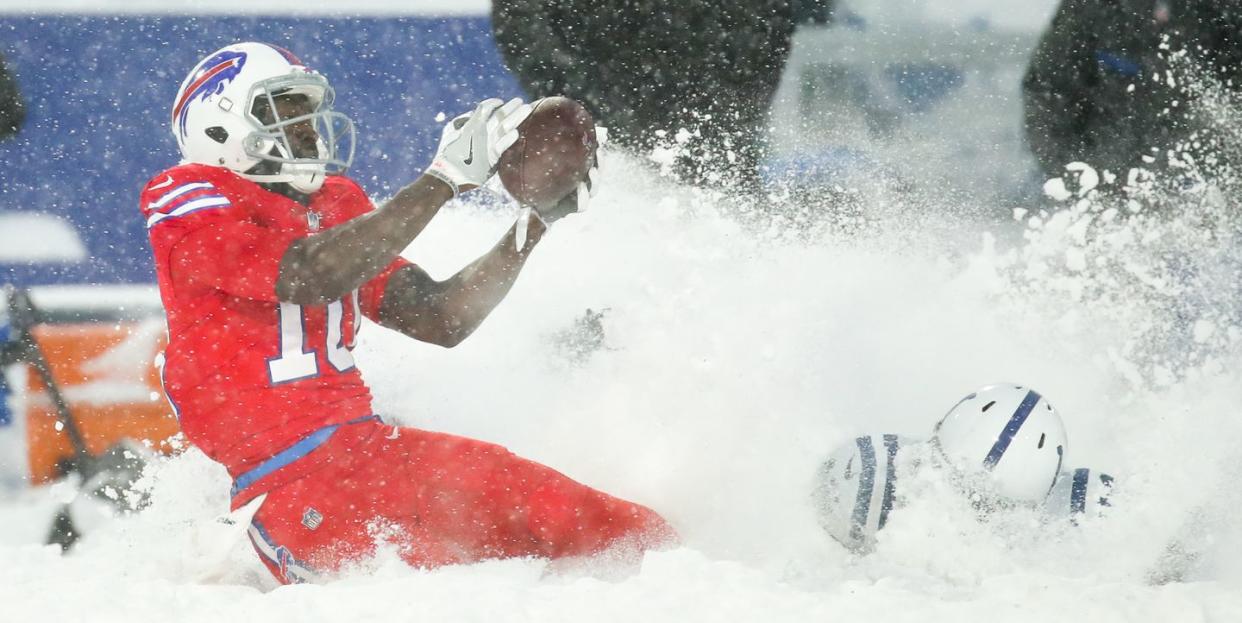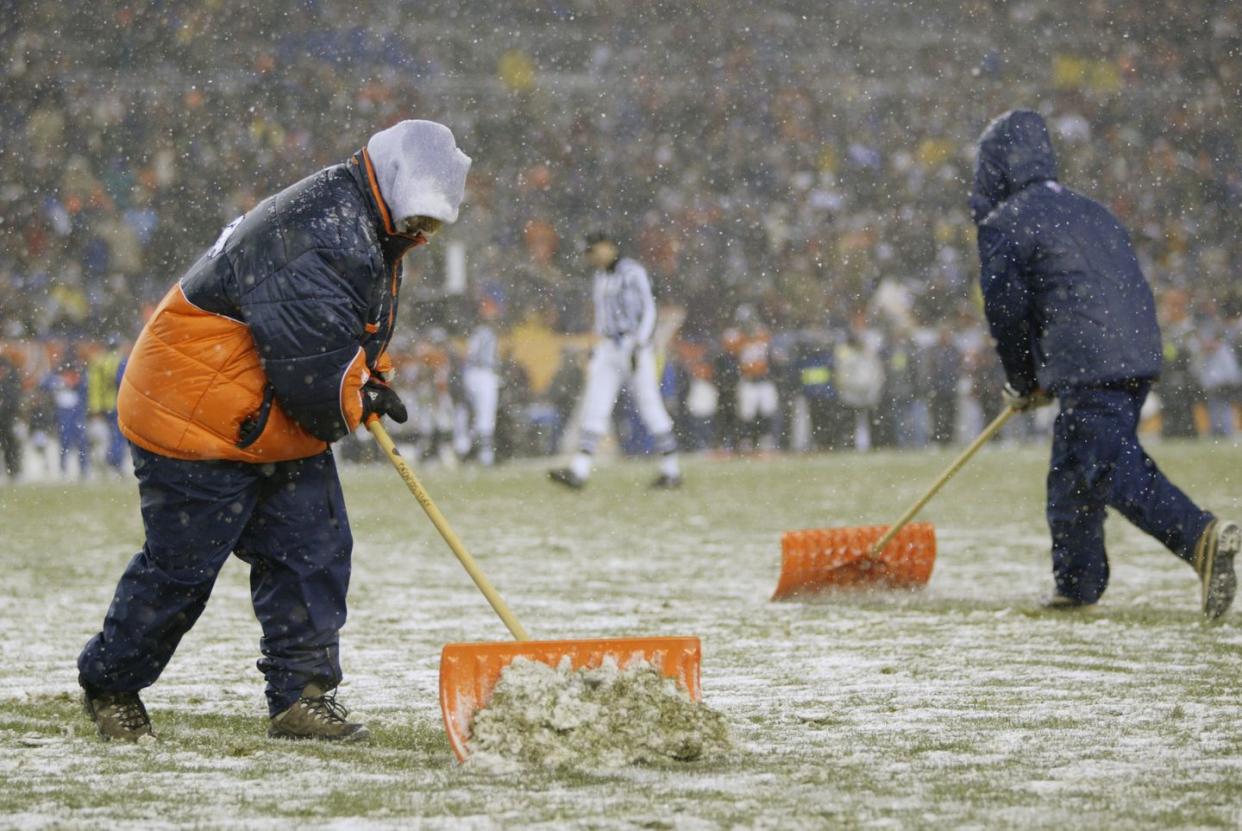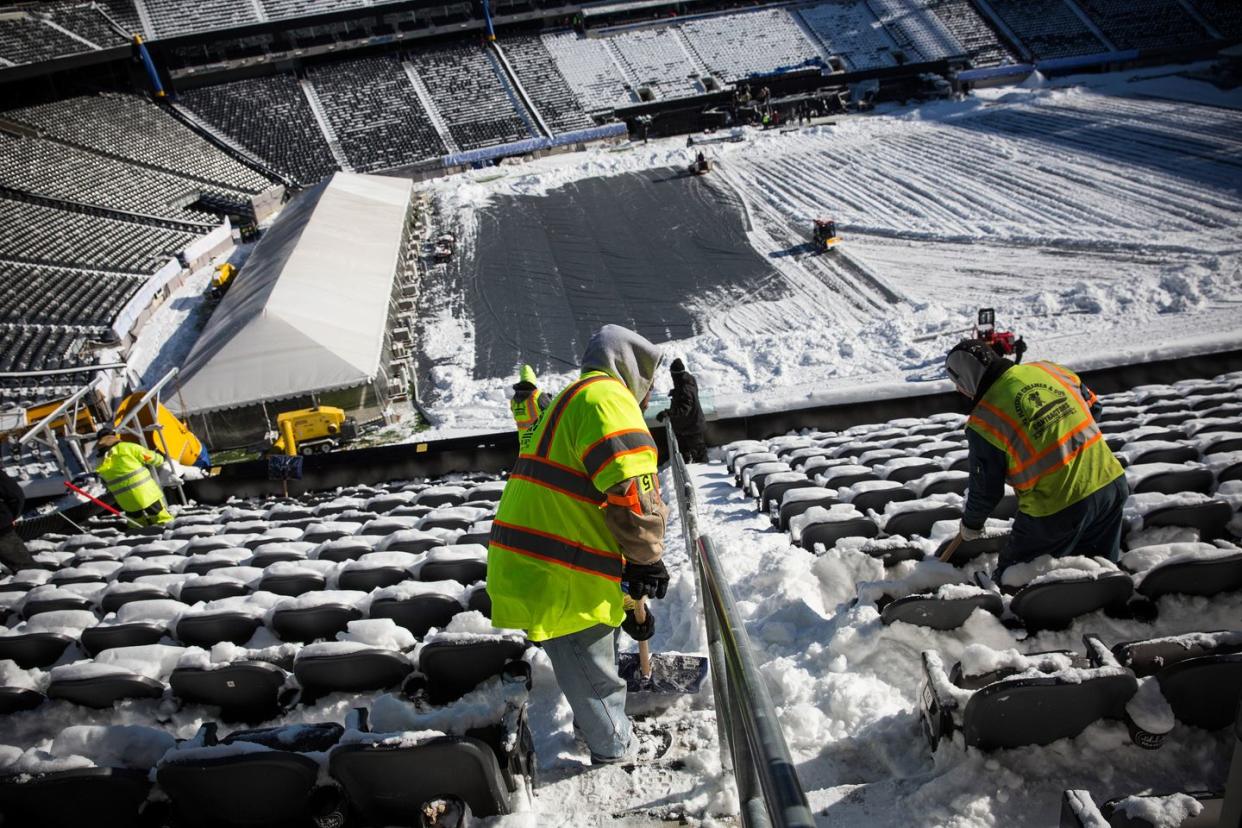How the NFL Deals With the Massive Headache of Frozen Football Fields

Buffalo’s Highmark Stadium is open-air, but the NFL relocated the Bills vs. Cleveland Browns game out of a desire to keep community resources available for non-football needs.
Most northern NFL stadiums have under-field heating systems to keep them from freezing—but not in Buffalo.
Cold weather impacts artificial turf differently than natural turf fields.
The Buffalo Bills were planning to host the Cleveland Browns in an NFL game Sunday afternoon. But then, the threat of multiple feet of snow pounding Buffalo, New York, turned the weather into the real opponent.
On Thursday, the NFL officially moved the game to Detroit—not out of concern about players and fans in the open-air Highmark Stadium, but because the NFL didn’t want to shift resources away from the community to deal with a football game.
❄️ Science explains everything. We’ll help you make sense of it all—join Pop Mech Pro.
Snow is a familiar challenge for American football. Especially in the north. Snow often comes with sub-freezing temperatures, cold enough to freeze the very ground the team plays on. There’s a difference, though, between natural grass and artificial turf when it comes to cold weather.
Natural grass is quick to freeze, thanks to the water content found both in the blades of grass and in the soil. Basically, once it’s cold enough to freeze that water content, the ground freezes, in turn, making it rock hard and potentially dangerous for players.
Artificial turf responds differently. With the blades made from synthetic materials and the infill often rubber, there’s no natural water content to freeze. Still, any moisture on the blades or still present in the infill system can freeze and turn the base hard and the blades extra slippery. Many artificial surfaces also mix sand into the base layer, which can retain moisture, so that portion can freeze when temperatures drop low enough.
In Buffalo, the only stadium to use A-Turf Titan 50—a polyethylene fiber with a woven, fabric backing designed to withstand absorption—the risk of a rock-hard field isn’t as likely as it would be if it used natural grass. In 2017, the last time the Bills hosted a game during a major snow event, players struggled to get their footing on the slick surface. The last time the Bills moved a game away from Buffalo due to weather was in 2014.
To fend off the threats of frozen turf, modern venues turn to under-field heating systems to keep both natural and artificial turf toasty. In Buffalo, though, the Bills play in the 1973-completed open-air Highmark Stadium with no roof covering the seats. And, no under-field heating system.

Under-field heating was not common back in 1973. “No, not at the time of the original Orchard Park Stadium,” Paul Griesemer, vice president of HNTB, the architectural firm responsible for the original design of Orchard Park in the 1970s, tells Popular Mechanics. Now, though, things are different. “[Under-field heating] is pretty common to maintain the stability [of the field], especially if you’re talking about natural turf. The groundskeepers like to maintain a very strategic root-zone temperature so that the grass stays active and that the surface meets the league’s impact criteria.”
Despite its frozen reputation, Green Bay’s Lambeau Field—the turf in Green Bay is a mix of synthetic fibers woven into a natural grass field—was the first in the NFL to install a hydronic heating system. That process involved burying pipes six inches to a foot beneath the turf and filling them with warmth to keep the soil and roots from freezing. A host of other stadiums would follow in the years to come.
Each groundskeeper finds an optimal temperature for their situation. In Green Bay, the 38 degrees Fahrenheit of the system keeps the roots above freezing, but cold enough to let the grass begin to harden off and get tougher. The Baltimore Ravens and Kansas City Chiefs have warmed soil to nearly 50 degrees, and there was a time the Philadelphia Eagles once pushed their system all the way to 60 degrees. Even at the extreme edges of heating the systems, it isn’t enough to start melting snow accumulating on the surface—it simply keeps the turf from freezing hard.
When it gets cold outside, teams can also prop up a tarp on the field and pump air under it, creating a blanket of warmth that keeps the surface dry. That strategy was used for over a month ahead of the only open-air cold-weather Super Bowl in the last few decades, the 2014 game at New Jersey’s MetLife Stadium.
The country’s north isn’t the only region with under-field heating. Griesemer says the domed Allegiant Stadium in Las Vegas, opened in 2020, has that feature, too. With a natural field that rolls outside for growth and back indoors for competition, he says that “moving from a hot climate to an air-conditioned climate [and they do have cold evenings]” means the system helps keep the soil from shock.

Fully indoor venues in cold-weather cities, whether Ford Field in Detroit or U.S. Bank Stadium in Minneapolis, offer artificial fields and no need for sub-field heating systems. But outdoor venues have little other protection against the cold. Canopies generally don’t offer cover for the field, sometimes shielding a certain number of fans from the elements. In Buffalo, the seats come unprotected, while at Seattle’s 20-year-old Lumen Field, a canopy covers roughly 70 percent of seats, generally protecting against the area’s well-known “liquid sunshine.”
“NFL facilities, if they are going to canopies or roofs, it is driven by the event schedule, along with fan comfort,” Griesemer says. “When we did Allegiant, [the dome] was for multiple things, especially fan comfort.”
Now, back to the Bills. They’ve announced plans for a new Buffalo stadium opening in 2026. It will come with a canopy focused on fan comfort by covering about 65 percent of the seats. It will also have a natural grass field. An under-field heating system to keep the field from freezing? Yeah, that’s planned too.
You Might Also Like
